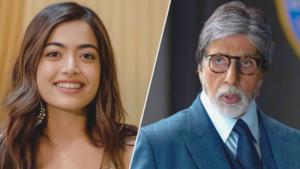Artificial Intelligence can be destructive. The most recent example is the viral Deepfake video featuring actor Rashmika Mandanna
Deepfake cybersecurity Rashmika Controversy 2023
Mandanna called the video “extremely scary”
In a post on X. The actor, who will next be seen in Animal, wrote, “Something like this is honestly, extremely scary not only for me, but for each and every one of us who is vulnerable to so much harm because of how technology is being misused.” see how a technology becomes headache Deepfake cybersecurity Rashmika Controversy 2023
https://x.com/iamRashmika/status/1721458881975693600?s=20
Acknowledging the video, Union Minister Rajeev Chandrasekhar reminded the social media platforms of their legal obligations to fight misinformation. “PM @narendramodi ji’s Govt is committed to ensuring Safety and Trust of all DigitalNagriks using Internet,” he posted on X.
https://x.com/Rajeev_GoI/status/1721398000701063460?s=20
Amitabh Bachchan shared a viral thread on X about the video and Deepfake and said it was a “case of strong legal action”.
Following Rashmika Mandanna, Katrina Kaif becomes a victim of Deepfake; the actress’s altered photo becomes widely shared.
Who is Rashmika Mandanna?
Deepfake cybersecurity Rashmika Controversy 2023 Before it she was doing her work fantastically. Rashmika Mandanna, an Indian actress who was born on April 5, 1996, is aptly referred to as a “Pan-India Actress” because she has appeared in films in Kannada, Tamil, Telugu, and Hindi. With a large national fan base, she’s been dubbed the ‘National Crush of India’
Rashmika gained notoriety in 2014 when she was crowned the Clean & Clear ‘Times Fresh Face’ champion. Since then, she has risen to prominence as one of India’s most well-liked actors, enjoying both critical and financial success.
With Rakshit Shetty in the film Kirik Party (2016), Rashmika made her acting debut. The crowd cheered for her, and she went on to win the “South Indian International Movie Awards” for “Best Debut Actress-Kannada.”
She starred in two commercially successful movies after making her debut: Chamak (2017) and Anjaniputra (2017).
Rashmika won the Zee Kannada Hemmeya Kannadathi Awards for “Best Actress” in recognition of her role in “Anjani Putra.” Subsequently, the ‘Pan-India Actress’ made her Telugu debut in the romantic drama Chalo (2018).
She also starred alongside Vijay Deverakonda in one of her biggest hits, Geetha Govindam (2018). She received multiple “Best Actress” honors for “Geetha Govindam,” including the Sri Kala Sudha Telugu Movie Awards,
After becoming one of the highest-paid and most sought-after actresses in the South film industry, Rashmika Mandanna is all set to make her Bollywood debut. She will be seen in Mission Majnu (2023) opposite Sidharth Malhotra and in Goodbye (2022) opposite Amitabh Bachchan, thereby working with, big banners like Rsvp, Reliance Entertainment and Balaji Motion Pictures respectively.
Family: Parents
Father : Madan Mandanna
Mother: Suman Mandanna
On 18 October 2021, she peaked Forbes India’s most influential actors on social media surpassing Samantha, Vijay Deverakonda, and Yash
How Deepfake Works
Deepfake have the ability to propagate misinformation, trick people, and jeopardize data security. They can be employed for nefarious activities such as impersonation, identity theft, and the production of convincing fake content for social engineering scams.
Deepfake have come under scrutiny after an actor named Rashmika Mandanna appeared in a doctored clip. These artificial intelligence (AI)-generated fake photos, voices, or videos appear realistic. This is the reason they pose a risk
What is a Deepfake video?
“Deep learning” and “fake” are combined to form the term “Deepfake.” It describes a video that has been altered with an algorithm to authentically replace the person in the original clip with a different person, usually a well-known person. Deepfake create images of fictitious events using a type of artificial intelligence known as deep learning. The prevalence of Deepfake videos has increased since the introduction of various AI tools. Certain AI tools are available for free and only serve to make the issue of phony images, videos, and audio worse.
What defines a Deepfake video and how can you spot one?
In a recent development, well-known actress Rashmika Mandanna has been drawn into a Deepfake cybersecurity Rashmika Controversy 2023. A woman can be seen entering an elevator in the now-viral video on social media, but her face has been digitally altered to resemble Mandanna. Numerous people are upset about this incident and are calling for legal action.The brief video clip, which is still making the rounds on social media, shows a woman dressed provocatively and playing the role of Rashmika entering an elevator.
She isn’t Rashmika, that’s all. Actor Katrina Kaif’s deepfake still photo surfaced later on Tuesday, attempting to mimic a well-known scene from the teaser for her upcoming movie Tiger 3.
Amitabh Bachchan, a Bollywood legend and co-star in the film Goodbye, expressed his worries about the Deepfake trend and advocated for legal action.
https://x.com/iamRashmika/status/1721458881975693600?s=20
A combination of “deep learning” and “fake” is “Deepfake.” It describes a class of artificial intelligence-generated media or content that makes use of deep learning algorithms in particular.
Deepfake are created by manipulating audio, video, image, or other digital content to show events that never happened. This is frequently done by swapping out a person’s voice or likeness for another.
Here are some key points to know about Deepfake:
- AI Technology: Deepfake are produced through the use of artificial intelligence, specifically deep neural networks. These networks are capable of deciphering and reproducing intricate patterns found in data.
- Face Swapping: Face swapping is a popular use for Deepfake. Using this technique, the face of one person is convincingly and realistically superimposed onto the body of another. It is possible to do this with politicians, actors, or even regular people.
- Voice Cloning: Deepfake technology isn’t just for altering images. Additionally, it can be used to accurately mimic someone’s voice, giving the impression that they are saying things they have never actually said..
- Issues: Deepfake give rise to serious moral and security issues. They can be used maliciously to disseminate false information, steal identities, engage in cyberbullying, or produce convincingly fake videos for illicit purposes..
- Detection and Mitigation: Tools and algorithms for identifying deepfakes are being developed. Scholars are attempting to detect manipulated content and guard against its detrimental usage..
- Legitimate Uses: Despite the negative publicity surrounding deepfakes, there are legitimate applications for them in a number of industries, such as research and development and the entertainment sector for dubbing and special effects..
- Legal and Ethical Considerations: In order to combat the improper use of this technology and safeguard people from harm, laws and regulations pertaining to deepfakes are constantly changing. Deepfake technology development and use must also take privacy and consent ethics into account.
It’s critical to understand that deepfakes exist and to proceed with caution when interacting with potentially manipulated media. It’s critical to stay up to date on the most recent advancements in deepfake technology as well as any potential risks as it develops.
Hackers are tricking organizations by using altered audio and video to steal money, data, or both. Here are some steps businesses can take to stay safe.
Deepfakes are becoming a more common tool used by cybercriminals in their attacks.
According to survey results from August, 66% of cybersecurity professionals surveyed had witnessed the use of deepfakes in a cyberattack.
In its eighth annual Global Incident Response Threat Report, VMware stated that this represents a 13% increase from the previous year. In 78% of those attacks, email was the means of delivery.
The following are recent accounts of criminals employing deepfakes:
- During Zoom calls, fraudsters employed a deepfake hologram of a chief communications officer for cryptocurrency to dupe executives into divulging sensitive information.
- Through the use of real-time voice cloning, thieves were able to mimic the voice of a director of a Dubai bank and trick a manager of a Hong Kong bank into sending $35 million to their organization. The manager “recognized it” over the phone because the fake voice sounded so realistic.
- An organization believed that they had employed a remote worker to handle technical support. Instead, they employed a criminal who used deepfake technology to create a false persona and steal personally identifiable information in order to access the company’s network and data.
- Hackers impersonating a CEO left phony voicemails requesting that staff members and outside vendors donate to humanitarian or disaster relief organizations or make investments through fictitious websites that diverted money to offshore accounts.
How Deepfake Video/image used
Video
- A face that appears to be blurry but not elsewhere in the picture or video (or vice versa)
- A shift in skin tone in the vicinity of the facial margins
- Double eyebrows, double chins, or double facial edges
- Whether a hand or other object partially obscures a face, causing it to become blurry
- Progressively worse portions of the same video
- Cropped effects and box-like shapes surrounding the mouth, eyes, and neck
- Blinking (or not blinking), unnatural movements
- Modifications to the lighting and/or background
- Contextual cues: Does the subject and foreground scene make sense together?
Audio
- Jumbled phrases
- Speech with varying tones and inflections
- Would the speaker use that particular phrasing?
- Context of message: Can they address related issues or is it pertinent to a recent conversation?
- Contextual cues: Do the sounds in the background match the speaker’s assumed location?
Hope we have all the information about this new controversial AI tool still we need to keep updating ourselves with new technological world to avoid these kind of crimes hoping that it will not repeat with anyone Deepfake cybersecurity Rashmika Controversy 2023
AI researcher Shweta Mohandas of the Centre for Internet and Society, a research organization based in Bangalore, observed on Deepfake cybersecurity Rashmika Controversy 2023 that the number of AI-based tools is rapidly increasing. “Technology is becoming faster and simpler. The true risk lies there. It can be applied to intimate partner violence and violence motivated by gender. That is very concerning, the woman told The Telegraph.
Such deepfake videos are simple to make using anyone whose photos are readily available on social media. And it’s getting really easy now that these programs handle a lot of the labor-intensive work, she said. In the past, one had to be proficient with programs like Photoshop to accomplish anything even slightly similar.
The proliferation of “deepfake video technology can have serious consequences which include shaming & targeting of women, implicating innocent people into videos of crime, fake targeting of individuals on social media, as well as manipulation during elections & in domestic politics,” according to a letter written by Trinamul Congress Rajya Sabha member Saket Gokhale on Tuesday to Rajeev Chandrasekhar, the minister of state for electronics and IT.
“Under the IT rules notified in April, 2023, platforms are required by law to ensure that no user posts false information AND to ensure that false information is removed within 36 hours of being reported by any user or the government.”
To stop these kind of misuse of Technology Government and company owner should start using identification of users Deepfake cybersecurity- Rashmika Mandanna Controversy 2023 is just start it will go long way if everybody doesn’t take individual responsibility.
To get these kind of informative news stay in touch https://daybydaynews.com/




